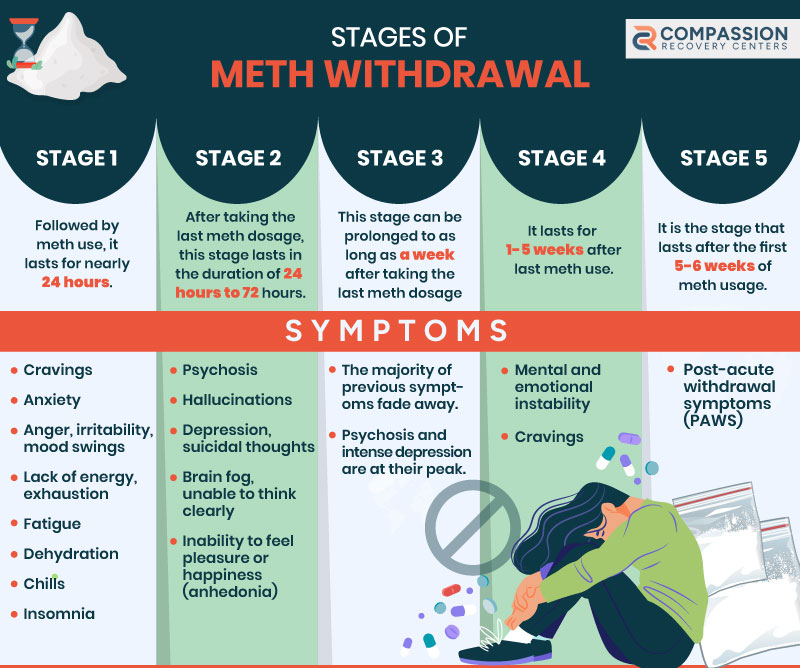Methamphetamine or Meth might stay in your system for longer spans, ranging from 2 days to 3 months. Meth is famous for giving intense but short-term “feel-good” or “high” sensations to its users.
The duration depends on certain factors, which are briefly explained in this article. In addition, you can enhance your knowledge of:
- How long does methamphetamine stay in your system?
- Features and consequences of meth misuse
- How is meth processed in the body?
- Meth drug tests and associated myth busters
- Complications concerning meth withdrawal
Struggling with meth addiction? Connect today with our Script Certified Health Professionals of renowned drug rehab at Compassion Recovery Centers via our confidential helpline (887) 414-3007.
Understand What is Methamphetamine
Meth, a short form of Methamphetamine, is classified as a Class II substance under the Controlled Substances Act by the US government since 1970. It is a psychoactive (mind-changing) stimulant that highly energizes one’s both mind and body.
It gives an immense and unmatchable sense of “rush” or “high” feeling after the first use that leads to consistently increased dosage while using every next time, just to get the same sensations. This ultimately gives rise to severe addiction to methamphetamine.
Before we further probe into its characteristics, here are some crucial statistics from National Survey on Drug Use and Health (NSDUH), 2021, depicting the alarming rise in meth addiction:
- There was found to be approximately 6% of the US population, referring to over 16.8 million individuals of age as low as 12 who had utilized meth at least once in their life spans.
- Also, the past annual data of meth users was averaged to be approximately 2.5 million individuals.
What Does Meth Look Like? Different Forms Of Meth
Meth is known worldwide by its several street names while some of the most famous ones include:
- Crank
- Trash
- Chalk
- Glass
- Ice Meth
- Speed
Different forms of meth include:
- Powder form
- Pills/capsules
- Crystalline form (also known as ice meth)
Methamphetamine is available in a variety of colors, such as:
- Gray
- White
- Orange
- Yellow
- Pink
- Brown

How Long Does Methamphetamine Stay in Your System? Have a Detailed Overview
On average, methamphetamine can stay in your system for at least 2-3 days. Certain factors determine how long does meth stay in your system. The prominent ones include:
- Route of administration (drug intake)
- Testing sample used for screening
- Dosage and purity of meth
- Frequency and duration of drug usage
- Metabolism rate of the person under observation
Suppose you are needed to provide a negative meth drug test for any particular job, license, or sport; you must be wondering how long does methamphetamine stay in your system?
Well, meth might be detected in your system, and it primarily depends on the testing sample. Let’s probe into the most common testing samples used for meth drug testing as follows:
How Long Does Methamphetamine Stay in Your Blood System?
If you are opting for a blood test to detect methamphetamine in your system, then you might find it detectable for up to 25 hours after using it.
However, your drug test result may vary with certain factors, like gender, age, frequency and duration of drug usage, metabolism, and overall health history.
How Long Does Methamphetamine Stay in Saliva?
In case of having an oral fluid or saliva test for meth detection, you might be able to give a positive drug test result for up to 48 hours. However, reducing the detection interval to 24 hours might give more accurate results.
How Long Does Methamphetamine Stay in Hair?
As compared to other meth detection tests, the hair follicle test for detecting meth in your system gives quite a significant detection time span i.e. 90 days (3 months). However, after quitting the use of methamphetamine, you still need to avoid using it for at least six months.
Hair test for meth detection is primarily applicable to research or forensic testing purposes rather than clinical testing.
How Long Does Methamphetamine Stay in Nails?
The meth detection interval of nails is similar to that of hair as they both are made of a common protein called keratin.
As your nails grow, substances in the body might be incorporated into the nails. Therefore, even a 2-3mm sized nail sample can show meth detection in your system after 3 to 6 months of methamphetamine usage.
How Long Does Meth Stay in Urine?
Depending on several factors, methamphetamine can be detectable in your urine sample for up to 3-5 days. If you are concerned about accuracy, you need to get yourself tested for meth detection for up to 3 days.
However, meth might be detected in your urine drug test even up to a whole week in case you are taking heavier doses of meth for a pretty longer duration.
Are you still confused about how long does meth last in your system? You can reach out to our script-certified health professionals to clear your thoughts. You can also fill out our confidential contact form for your desired information.
How Does Your Body Deal with Meth? Meth Metabolism
Being a psychoactive stimulant, meth induces alterations in the way you think and behave. Methamphetamine can be used in various ways, including:
- Oral intake
- Smoking
- Snorting
- Injecting
The quick impact of meth spreads in the body more rapidly if injected or smoked rather than if used via insertion and oral intake. The drug enters the bloodstream, moving all over the body. However, the primary deposition of the drug takes place in:
- Brain
- Liver
- Lungs
- Kidney
The brain induces a “pleasure effect” with consistent activity in brain cells. However, it might also cause death of brain cells, leading to loss of memory. Moreover, such after-effects may vary from person to person.
Do you know? It was estimated in a recent survey conducted in 2022 that 0.5% of grade-12 students, 0.3% of grade-10 students, and 0.2% of grade-8 students were reported to have used meth during the past 12 months. .
The major part of the remaining meth exits the body via urine. The rest of the meth is metabolized (broken down) into two components:
- Amphetamine (another addictive stimulant)
- Para-hydroxymethamphetamine (p-OHMA) (responsible for increasing blood pressure)
Eventually, these components are also meant to leave the body via urine.
How to Interpret Your Meth Drug Tests?
Meth drug tests are used for detection of meth misuse in a person’s body via any of the common testing samples, including blood, saliva, nail, hair, or urine. After sampling, your results can either be negative or positive.
However, a negative meth drug test might imply any of the two possibilities:
- Meth was not detected at all in the given sample.
- Meth was detected in a pretty small quantity that was negligible enough to be marked negative.
Moreover, the two possibilities after a positive meth drug test include:
- A considerable amount of meth was found in your given sample.
- It might also be a false-positive test, leading to follow-up testing.
Myth-Busters to Avoid Positive Drug Tests
Certain common myths make people believe they can make their meth drug tests result negative by following them. Unfortunately, they are not very reliable. Some of the most common ones include:
- Drinking 24-36 ounces of water might make your meth drug test result negative since water would dilute the urine enough to make the quantity of meth negligible. However, it may not work, as the lab tests would indicate that urine is more diluted than its normal range.
- Using diuretics (also known as water pills) also work on the same principle as urine dilution, but a higher amount of sodium in urine would confirm the use of diuretics to make your meth drug test result negative.
- Lastly, some people try hair bleaching since bleach can break down meth present into different chemical components. Nonetheless, the presence of those chemicals in hair samples can prove the presence of meth in the first place.
Therefore, the valid way to get your meth drug test result negative is to completely quit having meth or any kind of drug abuse for good.
A famous saying is:
There’s not a drug on earth that can make your life meaningful.
Are You Fully Aware of the Consequences?
Meth is one of the most addictive drugs globally, so if you or your loved ones are suffering from meth addiction, this is high time to consider the ill consequences of this addiction.
The adverse consequences of meth addiction would affect you in every area of life, ranging from your physical health to social well-being. Some of the prominent consequences of consistent usage of meth include:
- Malnutrition
- Memory loss
- Anxiety
- Paranoia
- Psychotic behavior
- Insomnia
- Confusion
- Aggression
- Cardiovascular disorders
- Liver & kidney diseases
- Intense dental health issues
- High risks of infectious disorders
Moreover, a long-term addiction can lead to:
- High body temperature
- Convulsions
- Death
Therefore, before meth addiction becomes uncontrollable for you, you need to take a step toward controlling it. No matter what symptoms you are experiencing, our DEA-certified drug rehab health professionals will employ their expertise and compassion to help you out of this lethal addiction.
Considering Meth Withdrawal Might Be a Life-Saver
If you are still struggling to quit taking meth or any kind of drug abuse, you need to know that there is still hope for you.
Keeping in view the worse symptoms you have to face during meth withdrawal, and no medication available to help you with this depressing state, you have come a long way. Still, the meth detoxification process can be pretty exhaustive. Therefore, it is highly recommended to initiate meth detox under strict medical surveillance so that you can heal for good.
Get Professional Help at CRC for a Complete Meth Detox
As a Legit Script-Certified Treatment Center, Compassion Recovery Centers (CRC) provides various substance abuse and drug rehab services to ensure safety among patients suffering from any kind of drug addiction.
Providing truly personalized experiences to patients, CRC offers in-person and virtual substance abuse treatment services.
Meth addiction treatment services at CRC would include:
Moreover, the primary elements of meth addiction treatment would include:
- Intake
- Detox
- Psychotherapy & Counseling
- Medication
- Aftercare
Still thinking about whether a drug rehab option is suitable for you? Our professional experts can motivate you and respond to your queries.
Get your question answered now.
Frequently Asked Questions about Meth Detox
Here, we have briefly explained some of the most frequent questions posed by our clients who are inquisitive about discovering answers to the burning question: How long does methamphetamine stay in your system?
How to Flush Meth Out of My System Fast?
To get rid of meth from your system fast, there are 4 proven strategies to assist you during the meth detox process:
- Stay well hydrated
- Eat a balanced diet rich in whole grains, fruits, vegetables, and lean protein.
- Maintain a regular exercise routine
- Try Sauna or sweat therapy
What can Prolonged Use of Meth Do to You?
Using methamphetamine for longer durations can induce severe physiological and psychological side effects. The prominent consequences include:
- Memory loss
- Irreversible alterations in brain structure and function
- Weight loss
- Tooth decay and loss
- Aggression
- Unpredictable behavior
- Mood disturbances
- Increased distractibility
- Hallucinations
- Paranoia
- Self-harm or self-suicidal thoughts
How to Tell if Someone is on Meth?
There are different signs you can look for to tell if someone has been misusing meth for a long time. Some of the significant signs refer to:
- Physical symptoms, like meth mouth, sores, scratches, hair thinning, etc.
- Unhealthy habits, such as insomnia and loss of appetite
- Emotional and mental instability
Is There Any Meth Detox Center Near Me in California?
Compassion Recovery Centers (CRC) is a well-renowned drug rehab center located in Laguna Hills, California. It features an advanced detox clinic along with inpatient and outpatient care facilities.
Moreover, if you want to seek professional help from the comfort of your home, you can also choose to get the telehealth services offered by CRC or fill out our confidential contact form. The DHCS-certified team of addiction therapy experts will help you explore the best treatment options for you or your loved ones. Just call at (887) 414-3007
Does Insurance Cover the Drug Rehab Program at Compassion Recovery Centers (CRC)?
Compassion Recovery Centers (CRC) prioritize the needs of their patients without letting financial constraints interfere with their progress toward well-being. The prominent insurances covered for the drug rehab program include:
Suppose your insurance plan does not fall in the above-mentioned categories. In that case, you can still enquire about your insurance program by calling (887) 414-3007. Since CRC is also connected with many other insurance carriers.
Resources
1. Methamphetamine. United States Drug Enforcement Administration (DEA). Available at: https://www.dea.gov/factsheets/methamphetamine
2. Methamphetamine Research Report. National Institute on Drug Abuse, NIH, USA. Available at: https://nida.nih.gov/publications/research-reports/methamphetamine/overview
3. Crystal Methamphetamine Fast Facts. National Drug Intelligence Center, U.S. Department of Justice. Available at: https://www.justice.gov/archive/ndic/pubs5/5049/5049p.pdf
4. Jayanthi, S., Daiwile, A. P., & Cadet, J. L. (2021). Neurotoxicity of methamphetamine: Main effects and mechanisms. Experimental neurology, 344, 113795. Available at: https://www.sciencedirect.com/science/article/abs/pii/S001448862100203X
5. Wagner, D. J., Sager, J. E., Duan, H., Isoherranen, N., & Wang, J. (2017). Interaction and transport of methamphetamine and its primary metabolites by organic cation and multidrug and toxin extrusion transporters. Drug Metabolism and Disposition, 45(7), 770-778. Available at: https://dmd.aspetjournals.org/content/45/7/770
6. Yasaei, R., & Saadabadi, A. (2018). Methamphetamine. Available at: https://www.ncbi.nlm.nih.gov/books/NBK535356/
7. Miech, R. A., Johnston, L. D., Patrick, M. E., & O’Malley, P. M. (2024). Monitoring the Future national survey results on drug use, 1975–2023: Overview and detailed results for secondary school students. Monitoring the Future Monograph Series. Ann Arbor, MI: Institute for Social Research, University of Michigan. Available at: https://monitoringthefuture.org/data/bx-by/drug-prevalence/#drug=%22Methamphetamine%22
8. Huestis, M. A., & Cone, E. J. (2007). Methamphetamine disposition in oral fluid, plasma, and urine. Annals of the New York Academy of Sciences, 1098(1), 104-121. Available at: https://www.ncbi.nlm.nih.gov/pmc/articles/PMC2709797/
9. Amphetamine Screen (Blood). Health Encyclopedia. University of Rochester Medical Center. Available at: https://www.urmc.rochester.edu/encyclopedia/content.aspx?contenttypeid=167&contentid=amphetamine_blood_screen
10. Suwannachom, N., Thananchai, T., Junkuy, A., O’Brien, T. E., & Sribanditmongkol, P. (2015). Duration of detection of methamphetamine in hair after abstinence. Forensic Science International, 254, 80-86. Available at: https://pubmed.ncbi.nlm.nih.gov/26197350/
11. Miller, S. C., Rosenthal, R. N., Levy, S., Saxon, A. J., Tetrault, J. M., & Wakeman, S. E. (2024). The ASAM Principles of Addiction Medicine: eBook without Multimedia. Lippincott Williams & Wilkins.Availableat: https://books.google.com.pk/books?hl=en&lr=&id=vWf1EAAAQBAJ&oi=fnd&pg=PT105&ots=lqq8G1wUgf&sig=7KEs5s_UG_AMfQ-LzUpGWWAc7Pw&redir_esc=y#v=onepage&q&f=false
12. Shu, I., Jones, J., Jones, M., Lewis, D., & Negrusz, A. (2015). Detection of drugs in nails: three year experience. Journal of Analytical Toxicology, 39(8), 624-628. Available at: https://academic.oup.com/jat/article/39/8/624/915323
13. Amphetamine Screen (Urine). Health Encyclopedia. University of Rochester Medical Center. Available at: https://www.urmc.rochester.edu/encyclopedia/content.aspx?contenttypeid=167&contentid=amphetamine_urine_screen
14. Drug Tests. Medline Plus, National Library of Medicine, US Government. Available at: https://medlineplus.gov/lab-tests/drug-testing/
15. Adulteration and Diltion Checks. Available at: https://www.sog.unc.edu/sites/default/files/course_materials/SchwabAdulterationSpecimenValidityChecks.pdf
16. Eisenbeiss, L., Binz, T. M., Baumgartner, M. R., Steuer, A. E., & Kraemer, T. (2020). A possible new oxidation marker for hair adulteration: Detection of PTeCA (1H‐pyrrole‐2, 3, 4, 5‐tetracarboxylic acid) in bleached hair. Drug testing and analysis, 12(2), 230-238. Available at: https://analyticalsciencejournals.onlinelibrary.wiley.com/doi/abs/10.1002/dta.2713
17. Dolezal, B. A., Chudzynski, J., Storer, T. W., Abrazado, M., Penate, J., Mooney, L., … & Cooper, C. B. (2013). Eight weeks of exercise training improves fitness measures in methamphetamine-dependent individuals in residential treatment. Journal of addiction medicine, 7(2), 122-128. Available at: https://pubmed.ncbi.nlm.nih.gov/23552821/
19. What are the long-term effects of methamphetamine misuse? Methamphetamine Research Report, National Institute on Drug Abuse. Available at: https://nida.nih.gov/publications/research-reports/methamphetamine/what-are-long-term-effects-methamphetamine-misuse
Did You Know? According to WHO, one out of every seven teens is struggling with some sort of mental illness.










